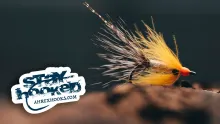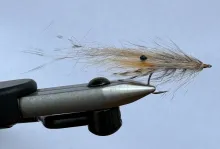I had known Magnus for many years, the fly being a stable fly in my flybox. But it was only later that I met the man Magnus "live".
It is always fun to meet someone you have heard of or known of for many years – a person who somehow has meant something to you.
That's how it was with Magnus, who had been sitting in my fly box for many years. A small gray and delicate fly, which had proved that it could catch fish time and time again. Because "Magnus" is a fly invented and tied for sea trout on the coast. A fly that has been named after its creator, furniture maker Magnus Ting Mortensen from Dalum by Odense River.
I had the pleasure of meeting Magnus "live", when he visited Samsø Højskole in the early 2000’s together with his close fishing friend Børge Hast. They wanted to join a course in the noble art of coastal fly fishing, which I was teaching – well knowing that they already had many years of experience and quite a few coastal trout on their conscience.
Ensign with a fishing rod
It was during this course that I got the true story of the fly and its creation.
Magnus himself originated from the Varde area in Southwest Jutland in Denmark – from Tranbjerg to be exact. No one in the family fished, so instead it was a man from the neighboring farm who took him out fishing. The trip went to one of Holme Stream’s runs, and here he caught brown trout on a float and worm. This was during the war where there was a lack of everything – bicycle tires included. The guy therefore had a wide motorcycle tire on the rear wheel of his bike – something that was hard to pull around in the sand when a kid was sitting on the back!
Magnus was later enrolled in the Danish military in Holstebro. Here he became an office ordinance and for a time shared an office with an ensign who had a fishing rod in the office. The ensign was married, but also had a girlfriend who was also married, Magnus recalled!
The ensign loved to fish and gladly brought the girlfriend to the river. But the fishing rod was banned in both homes, and could not be kept in either. So it adorned the office, and Magnus was allowed to borrow it when the ensign wasn’t fishing himself.
During a drill, Magnus had seen that there was a nice little stream cutting through the training ground. It was Gryde Stream, at that time running with clear water and beautiful brown trout. The soldiers had seen them when crossing the river – fully dressed – to reach positions on the opposite side. These were the fish that were fished with the ensign’s fishing rod.
Meeting with Saabye
Magnus moved to Funen in 1958 and became a cabinetmaker apprentice in Fangel near Odense River. Here he was allowed to fish on the water of the neighboring farm, and one day he encountered something as unusual as a fly fisherman in the meadows.
It was the renowned Danish angler and artist Svend Saabye himself who swung the rod at his home waters – probably one of the last times he fished here, as the creek was virtually empty of trout. But Magnus got a chat with the artist – and was hooked. He wanted to be a fly fisherman and tie his own flies!
Magnus learned to cast a fly – by studying the drawings in what at that time was basically only book on the subject – the Danish publisher Politiken's "I am an angler". Fly tying, on the other hand, required instruction. So he joined a local club where he learned to tie flies under expert guidance.
His first fly was a classic Red Tag Palmer, which would have great significance for his future development as a fly tyer. The dense body hackle on this pattern creates a fly that the fish have difficulties resisting. The same goes for the orange-red Swedish Chilimps and the more subdued Danish variant named Jysk Chilimps – flies which both fascinated Magnus.
Arnoldius
The cottage near Æbelø
When Magnus bought a cottage at Skåstrup on northern Funen, he began to take the long wading trip to Æbelø, an island connected to the mainland by a flooded path, on a regular basis. It was the spinning rod that was it in the late 1960s, because with that Magnus could cast and fish in all kinds of weather.
But then, on a spring day in 1973, he was on the north side of the island and saw two fine sea trout quite close to the shore. Magnus cast his lure and retrieved it, but with no effect. The fish ignored his offerings.
It was this experience that started the fly tying. The two sea trout were so close to shore that he could have reached them with a very short fly cast. And maybe they would have taken a little fly fished slowly instead of a fast moving lure?
Magnus went into thinking mode. At that time there weren’t a lot of special coastal flies to choose from. Coastal fly fishing was a largely unknown phenomenon. But Magnus knew one thing: the fly would be alive in the water if it was to catch anything!
"Magnus" is born
It had to have a bushy body hackle like the classic Red Tag Palmer. And it should look like a little shrimp, although Magnus didn't think of it as an exact imitation. As an active hunter, Magnus had easy access to one of the classic fly tying materials, hare. The body was made of hare wool dubbed on the tying thread.
It was more difficult with the hackle. But here, Magnus got the help of a good friend who had chickens of the striped Plymouth Rock breed. So the hackle became a "grizzly" hackle, as it’s called in the fly tying lingo, and the tail was made from two tips from the same feather. As a decoration, two red-painted bead chain eyes were added.
The fly got its debut the same Easter, where Magnus was wading over to Æbelø in a fresh eastern wind of the kind that is so common during the Easter period. On the north side of the island he found a place where wind and current had formed a backwater. Here, the water flushed back and forth, and a lot of food items were gathered for the fish.
That day Magnus succeeded in catching three fine sea trout on his new fly – a really good result in the days where fish were fewer, and every sea trout caught was a prize. The rumor of the new fly spread slowly, and one day in the late 1970s, three men took 17 fine sea trout on the fly, which had not yet been named.
The fly is babtised
As demand rose, a shop in Odense decided to tie and sell the new fly. In honor of the inventor it got the name "Magnus", and the fly has been popular ever since. Today, however, it has been a little forgotten due to the many new fly patterns, tied with fancy synthetic materials, but the fly is as good and productive as ever. The pattern recipe reads as follows:
Magnus:
Hook: Stainless steel hook size 4-6
Thread: Red
Tail: Two grizzly hackle tips
Rib: Oval silver tinsel
Body: Hare’s wool
Body Hackle: Grizzly rooster hackle
Front Hackle: Grizzly rooster hackle
Eyes: Bead chain
Head: Red nail polish
"Magnus" has a lot of sea trout on its conscience, and one of the largest was caught by its inventor himself – a nice fish measuring 79 centimeters. It was a fish that took the fly a cold spring day on the Danish island Langeland. The fish was landed by the fishing companion Børge. The year was 2001.
Magnus is one of the coastal fly fishermen who never goes to the coast without a line basket. On that he has obviously made himself – out of a dish bowl with pads glued to the bottom. He is a craftsman after all! And then he swears by intermediate lines that sink just below the surface. They do not disturb the surface like floating lines do – something that can be of importance in calm weather, where the trout are shy.
Hand picked for this article
- Log in to post comments












